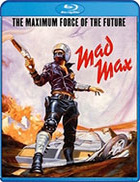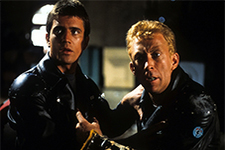| Director: George Miller | | Screenplay: James McCausland and George Miller (story by George Miller and Byron Kennedy) | | Stars: Mel Gibson (Max), Joanne Samuel (Jessie), Hugh Keays-Byrne (Toecutter), Steve Bisley (Jim Goose), Tim Burns (Johnny the Boy), Roger Ward (Fifi), Lisa Aldenhoven (Nurse), David Bracks (Mudguts), Bertrand Cadart (Clunk), David Cameron (Underground Mechanic), Robina Chaffey (Singer), Stephen Clark (Sarse), Mathew Constantine (Toddler), Jerry Day (Ziggy), Reg Evans (Station Master) | | MPAA Rating: R | | Year of Release: 1979 | | Country: Australia |  |
|  George Miller’s Mad Max is a B-movie pushing the limits of its potential. You can sense what the filmmakers were trying for—a gritty-cartoonish road rage epic—and you can almost picture them counting the change in their pockets, trying to figure out how they could translate the visions in their heads into a workable film. The movie wants to be more than it can be, so it ends up looking a bit strained in some places, although much of it is undeniably, viscerally effective, especially when Miller and cinematographer David Eggby (Pitch Black) get their cameras right in the middle of the automotive mayhem, ripping up the straight-line asphalt highways cutting through the Australian outback. First released in 1979, Mad Max introduced the world to a then unknown actor named Mel Gibson. He looks incredibly youthful in this film; smooth-faced and bright-eyed, he was only 21 during principal photography. Gibson has matured as an actor since this first outing (and gone through more than his share of career ups and downs and self-inflicted negative publicity), but even in this early work he displays the kind of robust masculinity mixed with feverish emotion that worked so well for him in American blockbusters like Lethal Weapon (1987) and its sequels and Braveheart (1995). He plays the title character Max, a highway patrolman in the near future (“a few years from now” a title card informs us) in which civilization still exists, but has begun to deteriorate for unexplained reasons, and the highways have become overrun with vicious gangs. Early on, Max is involved in a high-speed pursuit that results in the death of man known as Nightrider (Vincent Neil). Nightrider is a member of a motorcycle gang led by the flamboyant Toecutter (Hugh Keays-Byrne), who isn’t too happy with his friend’s demise. So, the gang takes it upon itself to track down Max and the rest of his police force to prove just how unhappy they are. After they succeed in burning Max’s partner, Goose (Steve Bisley), beyond recognition, Max decides to take some early retirement and go on vacation with his wife, Jessie (TV actress Joanne Samuel), and their 2-year old son. Max admits he’s scared, and he just wants to protect his family from all the insanity. But, part of the movie’s effectiveness is the way it conveys the scary idea that, no matter how hard he tries, Max simply cannot escape the insanity. With the entire world apparently on the cusp of complete collapse, no place is safe. Thus, the gang tracks Max and Jessie down, and, after a narrow escape, they make it to a relative’s house. But, even there in the quiet countryside, they are not safe. When all is said and done, Max has become “Mad Max,” and he is out for revenge. From there, the movie turns into standard revenge fare, with Max avenging the damage done to his family by knocking off the leather-clad gang members one by one. The movie should be given credit for developing a plausible and sometimes tender relationship between Max and Jessie because, without that, Max’s vengeance, which takes up the last third of the film, would have no underlying emotional currents to prop up the violence. The one twist Miller and co-screenwriter James McCausland (an American-born financial journalist) give us is that Max’s vengeful wrath begins to border on the psychotic (the word mad in the title is not meant to imply only anger). His actions slowly blur the boundaries between the traditional upstanding hero he was at the beginning of the movie and the relentless vigilante he becomes in the end. Mad Max becomes more complicated than it seems at first because it undercuts Max’s revenge, revealing it to be a hollow exercise that kills his enemies and provides cathartic excitement for the audience, but ultimately leaves him adrift and alone, “a shell of a man” as he is described in the superior sequel, 1981’s Mad Max 2 (aka The Road Warrior). One of the final shots of the film shows him driving down the highway, staring blankly ahead, which cements the idea that all this retribution really didn’t mean much in the end. Of course, what Mad Max is best known for is its clever chase scenes and thrilling stunts. First-time director George Miller, who went on to helm all the subsequent Mad Max sequels, as well as such disparate films as the moving medical drama Lorenzo’s Oil (1993) and the wonderful fantasy Babe: Pig in the City (1998), puts you right in the middle of the action sequences, squeezing every bit out of the tiny budget for consistently impressive effects. The scale of Mad Max is understandably limited, especially in comparison to the vastness of its sequels, but it generates a rumbling kind of thrill, the kind that can only be generated by real stuntmen doing what they do best, not camera tricks and postproduction special effects. | Max Max Blu-ray | | | Aspect Ratio | 2.35:1 | | Audio | Australian English DTS-HD Master Audio 5.1 surroundAustralian English DTS-HD Master Audio 2.0 monoU.S. English DTS-HD Master Audio 2.0 mono | | Subtitles | English | | Supplements | Audio commentary with art director Jon Dowding, cinematographer David Eggby, and special effects artist Chris Murray, moderated by Filmmaker Tim RidgeVideo interview with director George MillerInterviews with stars Mel Gibson and Joanne Samuel and cinematographer David Eggby“Mel Gibson: The High Octane Birth of a Superstar” featurette “Mad Max: The Film Phenomenon” featuretteTheatrical trailersTV spotsRadio spotsTrailers From Hell with Josh Olson | | Distributor | Kino Lorber | | Release Date | November 24, 2020 | | | COMMENTS | | Kino’s high-definition presentation of Mad Max derives from a new 4K digital intermediate and remaster of the original film elements (Kino is simultaneously releasing a 4K UHD, unseen by me). Presented in its original 2.35:1 aspect ratio, Mad Max looks better than ever, improving on both the 2002 DVD and the 2010 Blu-ray released by MGM. The transfer is crisp and clean, with no artifacts and few signs of age. We see particular improvement in the darker scenes, which are even smoother and clearer. Primary colors are bright and well-saturated without bleeding. As with previous releases, the Blu-Ray offers the viewer the option of both the original Australian English soundtrack and a dubbed American English soundtrack, which was created for the film’s U.S. theatrical release because the distributor feared that the Australian accents would be too hard to understand. The original monaural mix of the Australian soundtrack has been expanded to fill the lossless DTS-HD 5.1-channel surround track to generally good effect. Some of the imaging and directionality sound a bit forced, but the roar of the souped-up cars and the thunder of the explosions are given definite weight and presence. The Australian track is also available in its original monaural mix, as is the American dubbed soundtrack (it is instructive to switch back and forth between the two tracks to see just what a difference there is). In terms of supplements, we get a new 30-minute interview with director/co-writer George Miller, who had to be recorded via Internet video due to COVID restrictions (a familiar limitation we are seeing on many discs released these days). Limited image and sound quality aside, it is a great interview in which Miller discusses how he came to be a filmmaker after a short career in medicine, his working relationship with producing partner Byron Kennedy (who died in a helicopter crash in 1983), and the making of Mad Max. Also new to the disc is a two-minute episode of Trailers From Hell with Josh Olson about the film. We also get almost all of the supplements that appeared on MGM’s 2010 Blu-ray/DVD set (missing is the “Road Rants” trivia and fun fact track and an image gallery). The screen-specific audio commentary by art director John Dowding, cinematographer David Eggby, special effects creator Chris Murray, and Max Max collector and filmmaker Tim Ridge is definitely worth listening to. Recorded in one group session, it has a genial, laid-back quality, which doesn’t mean it isn’t full of interesting factoids, anecdotes, and insights into the film’s production. Also included are two featurettes, both of which are a bit disappointing. “Mel Gibson: The High Octane Birth of a Superstar” is even more relentlessly fawning of its subject than its title suggests. While I admire Gibson’s career and am consistently impressed with the range of his work, even I was put off by how much this 16-minute featurette sucks up to his superstar status (and, given his bad press over the past years, it plays even worse). The opening moments provide an interesting window into his early career via interviews with Betty Williams, an acting teacher at the National Institute of Dramatic Arts in Sidney where Gibson got his start, and producer Phil Avalon and actor John Jarrat, both of whom worked with him on his first movie, Summer City (1977). It goes downhill from there, though, as other interviewees are ready and willing to gush about Gibson, including Faith Martin, his first agent; Mitch Mathews, the casting director who cast him in Mad Max; Michael Park, the director of Tim (1979), which Gibson made immediately after Mad Max; and Piper Laurie, his co-star in that movie. “Mad Max: The Film Phenomenon” is a better featurette, although it is no less fawning of Gibson. Running about 25 minutes in length, it unfortunately contains no behind-the-scenes material, but rather relies entirely on interviews and footage from the movie. The featurette includes interviews with all of those who contributed to the audio commentary, as well as several film critics, including Australian film critic David Stratton, Andrew Johnston of US Weekly, and Kirk Honeycutt of The Hollywood Reporter. Most of the information covered here is also covered in the commentary, although there is a priceless moment when Tim Ridge pulls out the prosthetic head used for Toecutter's bulging eyes effect right before he smashes into the 18-wheeler. Also included are two U.S. trailers, four 30-second TV spots, and several radio spots. |
Copyright © 2020 James Kendrick Thoughts? E-mail James Kendrick All images copyright © Kino Lorber |



 (3)
(3)

